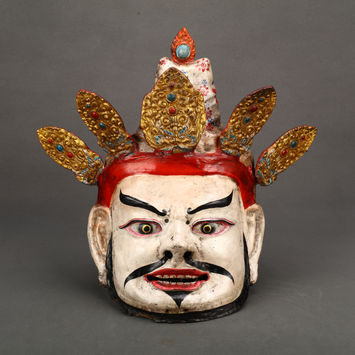
Yong's Gallery - Dancing Mask
Dancing Mask
Tibetan dancing masks are an integral part of Tibetan Buddhist culture, primarily used during ritualistic Cham dances. Cham, a sacred form of dance performed by monks or lay practitioners, is an important element of Tibetan Buddhist ceremonies, particularly during major festivals like Monlam (Great Prayer Festival) or Losar (Tibetan New Year). These dances and their accompanying masks serve both spiritual and cultural purposes, embodying Buddhist teachings, warding off evil spirits, and invoking blessings for the community.
The masks themselves are highly symbolic. They usually represent Buddhist deities, wrathful protectors, mythical beings, or spirits. For example, Yamantaka, a wrathful deity, symbolizes the conquest of death and ignorance, while Mahakala, another protector deity, represents the destruction of obstacles to spiritual growth. By donning these masks, performers are believed to channel the energy of the beings they represent, transforming the dance into a spiritual practice. Each mask is designed with specific symbolic features, such as horns, fangs, or a third eye, to reflect the divine attributes of the deity or spirit it portrays. The vivid colors and intricate designs of the masks are also deeply meaningful, with each hue representing specific aspects of Buddhist philosophy—for instance, white symbolizing purity, red for power, and black for protection.
Crafted from materials like papier-mâché, wood, or clay, Tibetan dancing masks are works of art in their own right. They are often elaborately painted with bright colors and adorned with details like gold leaf, brocade, or even semi-precious stones. The creation of these masks is considered a sacred act, often involving prayers and rituals to imbue them with spiritual significance. Monasteries or skilled artisans typically make the masks, ensuring that both the artistic and religious aspects are respected.
The Cham dance, in which these masks are used, is more than a simple performance—it is a form of meditation in motion. The dances tell stories from Buddhist scriptures, including tales of good triumphing over evil, the impermanence of life, and the path to enlightenment. Through elaborate choreography and the use of masks, the performers bring these teachings to life, making them accessible to the lay audience. The movements are often slow and deliberate, accompanied by traditional Tibetan instruments like drums, horns, and cymbals to create an otherworldly atmosphere. The dance is believed to purify the environment, drive away negative energies, and bring blessings to both the participants and the spectators.
In Tibetan culture, dancing masks and Cham dances also play a crucial role in preserving their rich spiritual and artistic heritage. They are not only religious rituals but also a way to pass down Buddhist teachings and cultural traditions through generations. In summary, Tibetan dancing masks are a profound fusion of art, spirituality, and storytelling, embodying the deep-rooted connection between Tibetan Buddhism and its cultural expression.
















